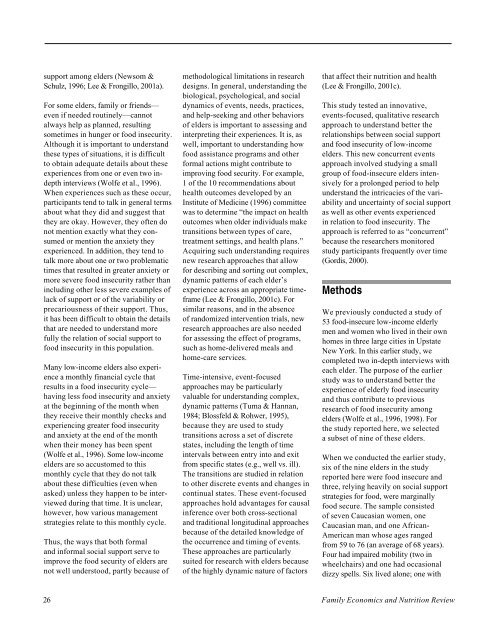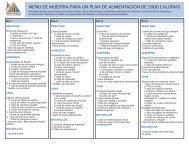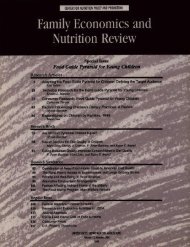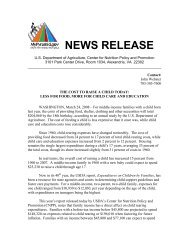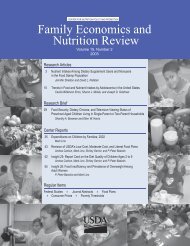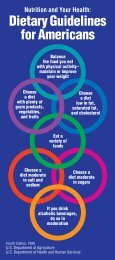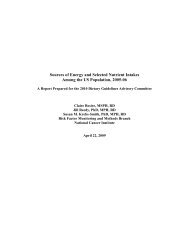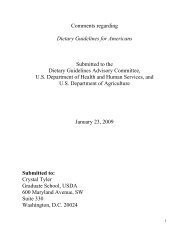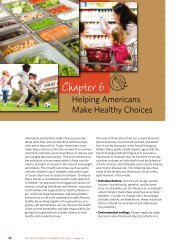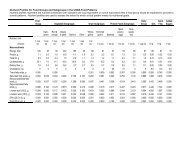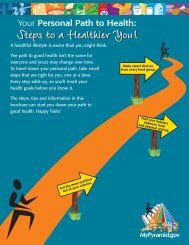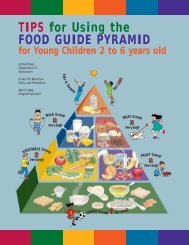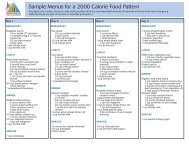Elderly Nutrition - Center for Nutrition Policy and Promotion - US ...
Elderly Nutrition - Center for Nutrition Policy and Promotion - US ...
Elderly Nutrition - Center for Nutrition Policy and Promotion - US ...
Create successful ePaper yourself
Turn your PDF publications into a flip-book with our unique Google optimized e-Paper software.
support among elders (Newsom &<br />
Schulz, 1996; Lee & Frongillo, 2001a).<br />
For some elders, family or friends—<br />
even if needed routinely—cannot<br />
always help as planned, resulting<br />
sometimes in hunger or food insecurity.<br />
Although it is important to underst<strong>and</strong><br />
these types of situations, it is difficult<br />
to obtain adequate details about these<br />
experiences from one or even two indepth<br />
interviews (Wolfe et al., 1996).<br />
When experiences such as these occur,<br />
participants tend to talk in general terms<br />
about what they did <strong>and</strong> suggest that<br />
they are okay. However, they often do<br />
not mention exactly what they consumed<br />
or mention the anxiety they<br />
experienced. In addition, they tend to<br />
talk more about one or two problematic<br />
times that resulted in greater anxiety or<br />
more severe food insecurity rather than<br />
including other less severe examples of<br />
lack of support or of the variability or<br />
precariousness of their support. Thus,<br />
it has been difficult to obtain the details<br />
that are needed to underst<strong>and</strong> more<br />
fully the relation of social support to<br />
food insecurity in this population.<br />
Many low-income elders also experience<br />
a monthly financial cycle that<br />
results in a food insecurity cycle—<br />
having less food insecurity <strong>and</strong> anxiety<br />
at the beginning of the month when<br />
they receive their monthly checks <strong>and</strong><br />
experiencing greater food insecurity<br />
<strong>and</strong> anxiety at the end of the month<br />
when their money has been spent<br />
(Wolfe et al., 1996). Some low-income<br />
elders are so accustomed to this<br />
monthly cycle that they do not talk<br />
about these difficulties (even when<br />
asked) unless they happen to be interviewed<br />
during that time. It is unclear,<br />
however, how various management<br />
strategies relate to this monthly cycle.<br />
Thus, the ways that both <strong>for</strong>mal<br />
<strong>and</strong> in<strong>for</strong>mal social support serve to<br />
improve the food security of elders are<br />
not well understood, partly because of<br />
methodological limitations in research<br />
designs. In general, underst<strong>and</strong>ing the<br />
biological, psychological, <strong>and</strong> social<br />
dynamics of events, needs, practices,<br />
<strong>and</strong> help-seeking <strong>and</strong> other behaviors<br />
of elders is important to assessing <strong>and</strong><br />
interpreting their experiences. It is, as<br />
well, important to underst<strong>and</strong>ing how<br />
food assistance programs <strong>and</strong> other<br />
<strong>for</strong>mal actions might contribute to<br />
improving food security. For example,<br />
1 of the 10 recommendations about<br />
health outcomes developed by an<br />
Institute of Medicine (1996) committee<br />
was to determine “the impact on health<br />
outcomes when older individuals make<br />
transitions between types of care,<br />
treatment settings, <strong>and</strong> health plans.”<br />
Acquiring such underst<strong>and</strong>ing requires<br />
new research approaches that allow<br />
<strong>for</strong> describing <strong>and</strong> sorting out complex,<br />
dynamic patterns of each elder’s<br />
experience across an appropriate timeframe<br />
(Lee & Frongillo, 2001c). For<br />
similar reasons, <strong>and</strong> in the absence<br />
of r<strong>and</strong>omized intervention trials, new<br />
research approaches are also needed<br />
<strong>for</strong> assessing the effect of programs,<br />
such as home-delivered meals <strong>and</strong><br />
home-care services.<br />
Time-intensive, event-focused<br />
approaches may be particularly<br />
valuable <strong>for</strong> underst<strong>and</strong>ing complex,<br />
dynamic patterns (Tuma & Hannan,<br />
1984; Blossfeld & Rohwer, 1995),<br />
because they are used to study<br />
transitions across a set of discrete<br />
states, including the length of time<br />
intervals between entry into <strong>and</strong> exit<br />
from specific states (e.g., well vs. ill).<br />
The transitions are studied in relation<br />
to other discrete events <strong>and</strong> changes in<br />
continual states. These event-focused<br />
approaches hold advantages <strong>for</strong> causal<br />
inference over both cross-sectional<br />
<strong>and</strong> traditional longitudinal approaches<br />
because of the detailed knowledge of<br />
the occurrence <strong>and</strong> timing of events.<br />
These approaches are particularly<br />
suited <strong>for</strong> research with elders because<br />
of the highly dynamic nature of factors<br />
that affect their nutrition <strong>and</strong> health<br />
(Lee & Frongillo, 2001c).<br />
This study tested an innovative,<br />
events-focused, qualitative research<br />
approach to underst<strong>and</strong> better the<br />
relationships between social support<br />
<strong>and</strong> food insecurity of low-income<br />
elders. This new concurrent events<br />
approach involved studying a small<br />
group of food-insecure elders intensively<br />
<strong>for</strong> a prolonged period to help<br />
underst<strong>and</strong> the intricacies of the variability<br />
<strong>and</strong> uncertainty of social support<br />
as well as other events experienced<br />
in relation to food insecurity. The<br />
approach is referred to as “concurrent”<br />
because the researchers monitored<br />
study participants frequently over time<br />
(Gordis, 2000).<br />
Methods<br />
We previously conducted a study of<br />
53 food-insecure low-income elderly<br />
men <strong>and</strong> women who lived in their own<br />
homes in three large cities in Upstate<br />
New York. In this earlier study, we<br />
completed two in-depth interviews with<br />
each elder. The purpose of the earlier<br />
study was to underst<strong>and</strong> better the<br />
experience of elderly food insecurity<br />
<strong>and</strong> thus contribute to previous<br />
research of food insecurity among<br />
elders (Wolfe et al., 1996, 1998). For<br />
the study reported here, we selected<br />
a subset of nine of these elders.<br />
When we conducted the earlier study,<br />
six of the nine elders in the study<br />
reported here were food insecure <strong>and</strong><br />
three, relying heavily on social support<br />
strategies <strong>for</strong> food, were marginally<br />
food secure. The sample consisted<br />
of seven Caucasian women, one<br />
Caucasian man, <strong>and</strong> one African-<br />
American man whose ages ranged<br />
from 59 to 76 (an average of 68 years).<br />
Four had impaired mobility (two in<br />
wheelchairs) <strong>and</strong> one had occasional<br />
dizzy spells. Six lived alone; one with<br />
26 Family Economics <strong>and</strong> <strong>Nutrition</strong> Review


